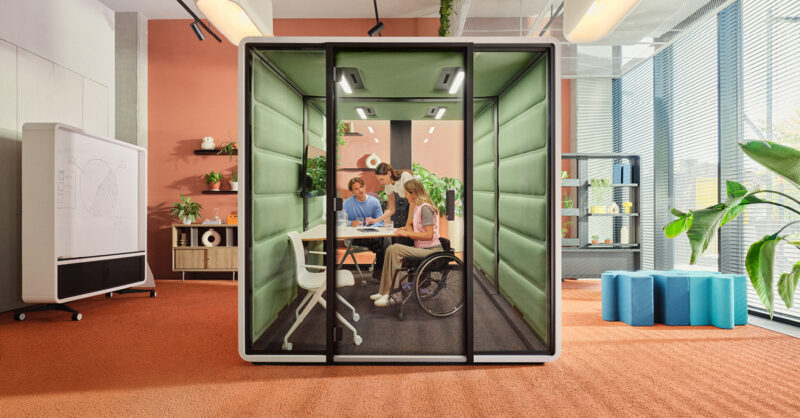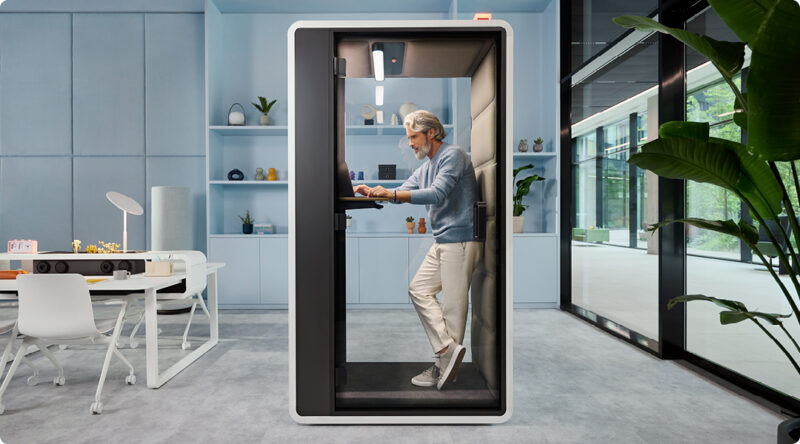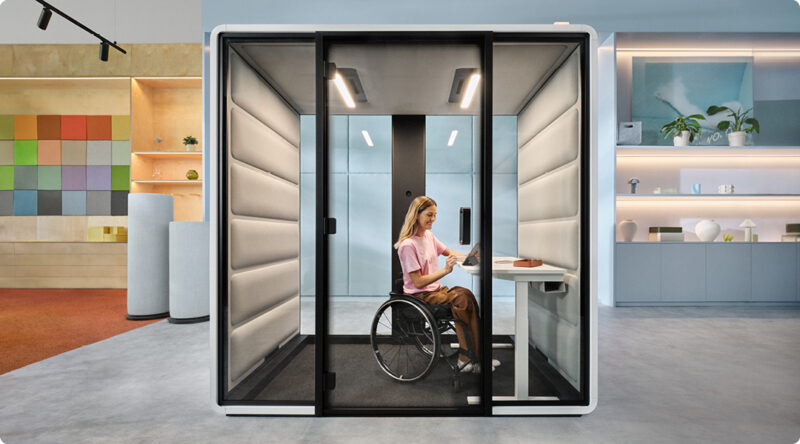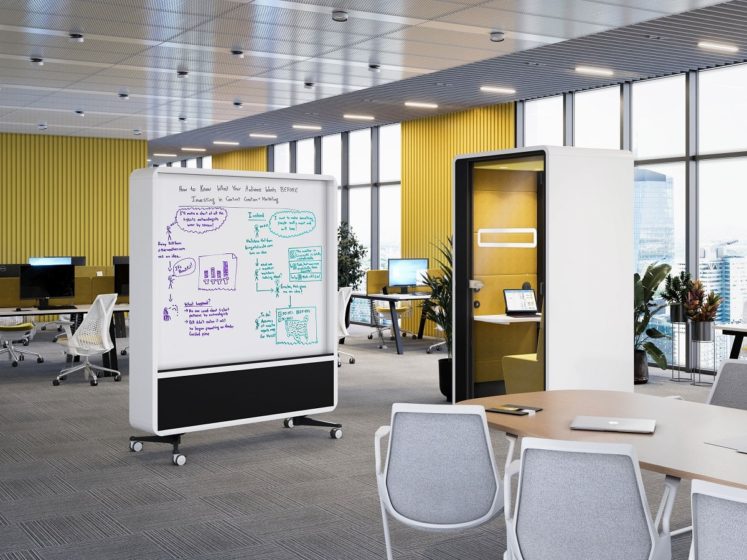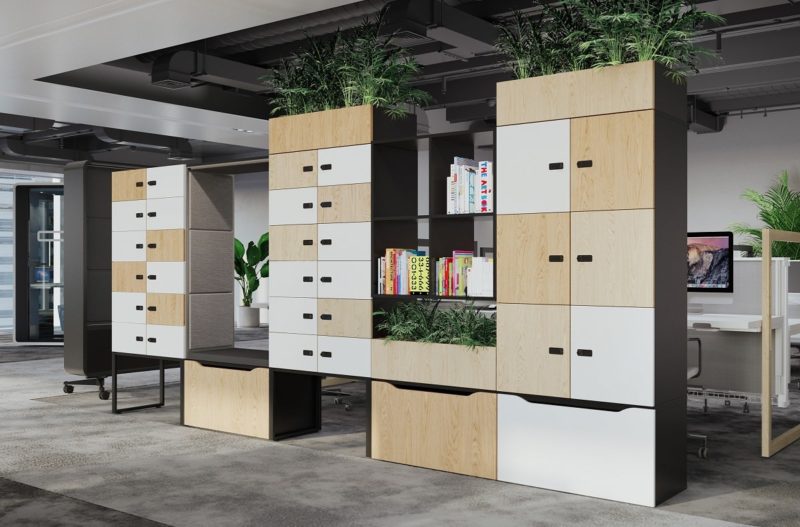Designing an inclusive office for neurodiverse staff
- Posted on: 11 February 2022
- By: Hushoffice Team
These days, employee wellness comes first. In order to strengthen it, workplace layout has to promote neurodiversity. It needs to accommodate the unique viewpoints of every staff member. The following suggestions should assist you in creating an area characterised by inclusiveness whether you are designing a new office or revamping an existing one. Only in an inclusive, thoughtfully designed environment can neurodivergent staff thrive and succeed.
The inclusive workplace layout – main conclusions:
- Neurodiversity refers to inherent variations in individuals’ cognitive functioning. Everything depends on our ability to incorporate various senses — the way our brains interpret external stimuli. Unlike neurotypical individuals, who respond to sensory information in a predictable way, neurodiverse individuals can react differently.
- Our five senses are involved in the neural process; therefore, all it takes to cater for neurodiversity is to approach the working environment from a sensory perspective.
- Designing with neurodiversity in mind means planning inclusively – also known as a versatile or inclusive plan.
- Everybody gains from workplace layout that takes neurodiversity into account. Consider soundproof office booths that offer enhanced acoustic environments for both neurotypical and noise-sensitive neurodiverse staff.
- When you adapt the workplace for neurodivergent staff, pay particular attention to these seven fundamentals: visual privacy, acoustic features, illumination, mobility, navigation, airflow, and zoning (partitioning area).
How can we define neurodiversity?
Neurodiversity refers to the inherent variations in an individual’s neurological functioning. In other words, everyone has a unique way of thinking. Everybody’s brain interprets information, also known as sensory stimuli, in a distinct way. This results from the individual characteristics of our brains. Additionally, there are various factors affecting our cognitive processes, including age, cultural background or our character.
Everything depends on our ability to incorporate various senses — the way our brains interpret information from different senses.
The capacity for interpreting several incentives or sensory information simultaneously is known as sensory integration with “sensory” being the key term here. As far as the neural process is concerned, the five senses — visual, auditory, gustatory, olfactory, and tactile — are responsible for it. Have you ever tried to engage in a conversation while navigating through an unfamiliar place? Or attempted to find your way while simultaneously maintaining a lively dialogue? You probably needed to halt speaking or strolling in order to get your bearings. That’s sensory integration in action — that’s how many different stimuli people’s brains are able to interpret simultaneously.
Creating a neurodiverse workplace layout requires taking into account all five senses.
– emphasises Mateusz Barczyk, Senior Brand Manager, Hushoffice.Multisensory perception is a necessary approach for designing work environments. Workspaces are typically planned with both aesthetics and practicality in mind. However, we must keep in mind that both our eyes and our ears are taking in information from the workplace, too. The reaction, whether favourable or unfavourable, to the setting is influenced by every sensory encounter we have
Depending on their cognitive functioning, each employee has their individual sensory experience of their workspace. Due to the differences in how human brains are programmed, each of us views colours, hears commotion, and interprets space in various ways. Hence, accommodating neurological variations with the utilisation of five senses as benchmarks is the core of designing with neurodiversity in mind.
Whilst neurotypical individuals respond to sensory information in a predictable way, neurodiverse individuals don’t.
The reason for this fact is compromised sensory integration. Brains of neurodiverse individuals frequently have trouble interpreting multiple different stimuli at the same time. The neurodiverse may find several different stimuli to be diverting, or even annoying, which can lead to sensory overload.
Approximately 15% to 20% of individuals are neurodivergent.
Developmental coordination disorder, Tourette’s, developmental delay, attention-deficit hyperactivity disorder, dyscalculia, Asperger’s, autism spectrum disorder, obsessive–compulsive disorder, or word blindness are all examples of cognitive disabilities that contribute to an individual’s neurodiversity.
Compared to neurotypical employees, individuals with attention-deficit hyperactivity disorder are more likely to be disturbed by workspace activity.
Autism spectrum disorder can frequently cause hyperresponsiveness to materials and scents. At times, it’s difficult for individuals with word blindness to understand spoken words in loud settings. In certain situations, individuals with developmental coordination disorder might experience heightened photophobia. To feel comfortable, obsessive–compulsive disorder sufferers require a neat and tidy environment. With an open-space design, each of the above sensory elements flows naturally. Furthermore, it is essential to enhance the above sensory elements so as to increase inclusivity in the workplace, especially since 15% of the staff is neurodiverse.

If someone has compromised sensory integration, it may impact all five senses.
The more senses are affected, the more challenging it becomes for an individual to operate in an ever-changing environment with a lot of shifting sensory information. For instance, a buzzing open-play workplace.
Efficiency, wellness, and cognitive functioning remain all intimately related.
It’s essential to understand how workers respond to sensory input in the office as the workspace, like any environment, consists of various stimuli. In other words, we perceive the workplace through all five senses. Therefore, even the smallest layout decisions, such as the colour or pattern of the floor, can have a favourable, neutral, or unfavourable impact on our senses. Consequently, our ability to feel good, concentrate, and think clearly is affected.
How does being neurodiverse in the open-plan workplace feel?
For reference, watch the augmented-reality immersive film by BBC’s CAPE project. The material provides you with a realistic, immersive glimpse into what the average workplace feels like for neurodiverse individuals. The film compellingly emphasises how crucial it is to plan inclusivity-oriented office environments.
– states Mateusz Barczyk, Senior Brand Manager, Hushoffice.Designing a workspace where all five senses are thoughtfully addressed enhances the experience for all employees. This is a step towards rendering the workplace a beloved location, not only a place of employment. Staff members eagerly anticipate their workdays in the office when they are in for a pleasurable time. Furthermore, their efficiency in the office is higher. Thus, establishing an optimal workplace for all staff members and learning how to handle sensory stimuli to support neurodiversity are essentially the same thing
Is your office layout prepared to accommodate neurodiversity?
Review the BBC CAPE work’s Environmental Checklist. Once you’ve analysed it, you’ll understand how cognitively receptive your space is by assessing the touch, smell, sight, and sound components.
Designing an office with neurodiversity in mind involves planning inclusively.
A wide range of tastes are catered to while planning for the sake of neurodiversity— tastes of both neurotypical and neurodiverse workers. For this reason, neurodiversity in the office is also referred to as a versatile or inclusive plan — it has a positive impact on everyone. Accommodating the whole range of employee preferences makes inclusivity-oriented environments productive.
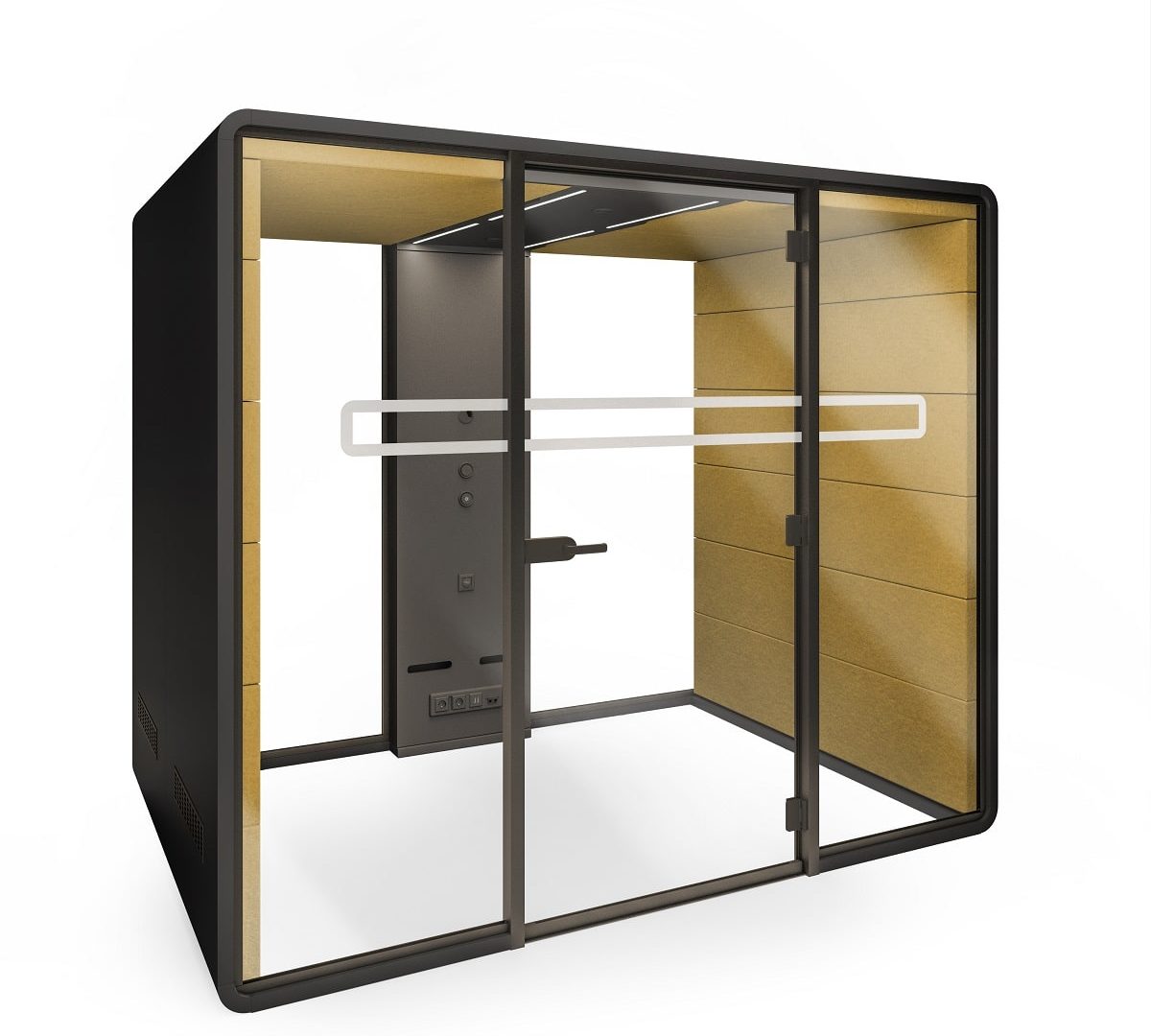
Everybody gains from workplace layout that takes neurodiversity into account.
Let’s consider the following example. Neurodivergent Individuals may occasionally struggle with handling interruptions, which makes them more likely to experience anxiety in a distracting office environment. Actually, though, interruptions irritate workers of all stripes to a certain extent. When we minimise interruptions, our actions go beyond simply getting rid of a critical hurdle to the success of neurodiverse employees. We design a more tranquil and efficient work environment that benefits all workers.
Think about soundproof office booths that provide an acoustic environment for workers of various stripes.
Acoustics, for example. Individuals who are responsive to commotion may profit from employing acoustic booths that enhance the soundscape of the area as well as minimise workplace commotion. However, individuals who are just occasionally annoyed or interrupted by collaborative bustle or other workplace noises gain from it, too.
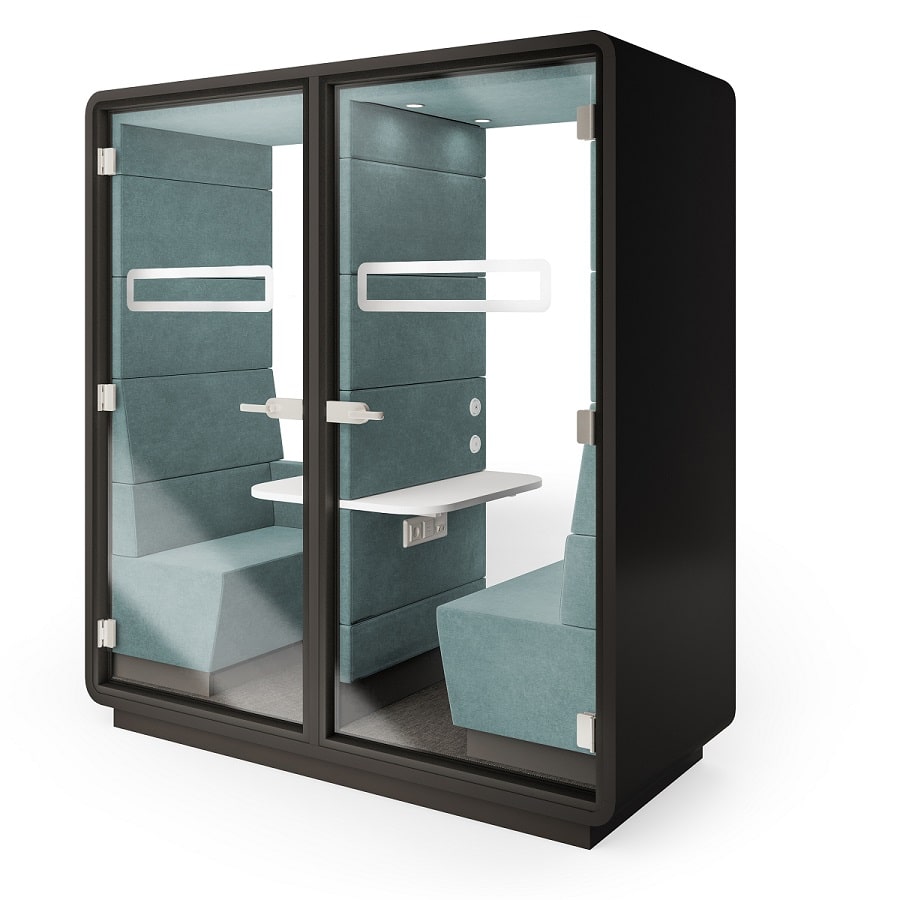
If you’re curious about what it is like inside an acoustic booth, read the following: Personal booths. How does the confidentiality of a workplace booth really feel?
Neurodiversity provides an edge over competitors.
When used wisely, diversity may be a unique advantage. Superb abilities which are not innate in neurotypical individuals are associated with some neural conditions. When it comes to neurodiverse individuals, their “impairment” can often turn out to be their superpower.
Neurodiverse individuals tend to be incredibly creative and astute problem-solvers.
They frequently possess a natural aptitude for specialised abilities, such as computer programming, pattern identification, and creative thinking. Thus, staff with greater diversity possesses greater inventive and cognitive potential. Additionally, diverse employees can build rapport with diverse consumers.
It all comes down to offering individuals options and allowing their senses to lead.
As noted earlier, our senses help our brains interpret the surrounding world. Therefore, our aim is to provide diversity in terms of senses. Our goal is to offer choices. A range of illumination standards, temperature settings, acoustic landscapes, or similar elements. These kinds of alternatives provide staff members with the freedom to perform their tasks within the areas that best suit their requirements and likings. To put it briefly, they are in control of their environment.
We discussed before the way this type of command keeps people from job burnout: Is the open space a source of office burnout?
When you adapt the workplace for neurodiverse staff, pay particular attention to these seven fundamentals.
Enhancing the following seven components is going to result in a more inclusivity-oriented environment: zoning (partitioning area), mobility, navigation, acoustic features, illumination, airflow, and visual privacy.
1. Zone the workspace using office privacy booths and space dividers
The goal is to deliver an attractive work environment where workers may choose the area where they feel most at ease and concentrated. So we achieve it through employing sensory reasoning. Each and every sense… the things we can observe, taste, sniff, hear or touch. By allowing our five senses to guide us, we are establishing a top-notch, enjoyable space
– offers Mateusz Barczyk, Senior Brand Manager, Hushoffice.
This will enable you to provide various environments with varying levels and types of stimulation.
Sensory overload can be avoided via segmenting.
Quiet zones should be limited in stimuli. Active zones should be high-energy. Offering hands-on tactile elements to help kinesthetic learners focus is a good idea too.
Whilst certain areas ought to be enclosed and confidential, others ought to be uncovered and communal.
Furthermore, every area optimally provides a unique sensory setting. Unique as far as sound qualities, aesthetics or illumination are concerned. Thus, on the whole, diversity is present, so workers can feel free to select the appropriate area at a given time.

Does occupational burnout pose a problem? Check out the following article: Five strategies to prevent burnout in an open space.
Quiet office booths and peaceful areas are essential for providing a sensory retreat.
Some individuals don’t like solitude, while others require regular getaways from open-office stimuli. For some employees, minimalist areas are simply the finest as far as carrying out job tasks is concerned. Acoustic office booths, such as the Hushoffice collection, and peaceful areas are beneficial for everyone. .
Simple as well as wholesome.
Peaceful areas ought to be tranquil settings for detaching, unwinding or rejuvenating. A brief respite for our senses. It is especially important for people who feel significantly affected by their work environment. Each staff member benefits when isolation and privacy are provided by introducing private office booths or area partitions. For example, people with social phobia might revel in quick recharges inside a privacy booth and enclosed pod. By implementing such solutions, it is possible to render the workplace an environment where everyone may work to their maximum potential.
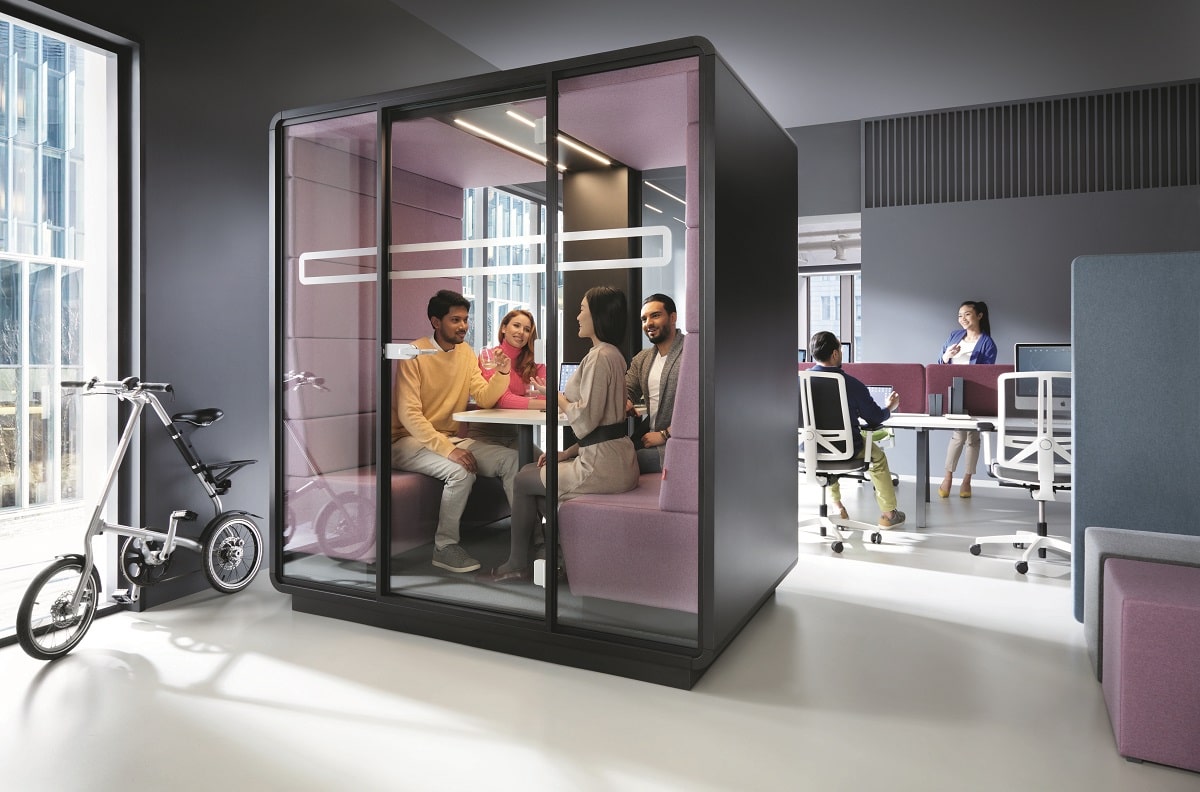
2. Boost navigational ease
A neurodiverse employee’s wellness depends on feeling comfortable as well as in charge of their environment. Not to mention, their ability to focus. Assist employees in both navigating the space and feeling comfortable. Make your environments interesting and remarkable.
To establish a comforting feeling of intimacy as well as harmony, utilise recurring layout components.
In this case, colour choice may be helpful. Also, compelling central elements such as graphics might aid in staff navigation. It’s essential to use unambiguous and coherent symbols.
Put on view relevant details in a clearly visible location.
Every area and environment ought to be simple enough to use and facilitate wayfinding. Generally speaking, stay away from floors with repeated designs as they may be disturbing to move around on, triggering uneasiness.
3. Provide your staff members with mobility chances
It is something significant for twitchy staff members. Meeting kinaesthetic demands constitutes a fundamental component of the versatile plan. People with focus deficit issues often find it easier to concentrate when they are in motion. They can let go of their feverish emotions and feel more relaxed as a result. Through motion neurodiverse workers are able to remain more focused on the task at hand.
When it comes to workplace layout, motion may take numerous shapes.
For example, height-configurable workstations might be excellent for staff members who are always on the go for whatever reason. It’s also highly beneficial for people with spinal issues as moving around the office can help keep such problems at bay. Moreover, sit-stand workstations may increase efficiency. In fact, some people come up with their most innovative ideas when standing rather than sitting.
Movement is the cornerstone of good ergonomics.
Our organisms are not intended for prolonged sedentary desk work; rather, they are meant for constant mobility. It benefits the intellect as well, facilitating a variety of operations and activating various areas of the human brain. Once more, this illustrates how each staff member prospers in different ways as a result of the support for the neurodiverse. And how ergonomics along with other wellbeing-oriented concepts seamlessly mesh with the idea of a versatile or inclusive plan.
Some additional guidelines to consider:
- Make sure that mobility is encouraged in active areas — think about portable whiteboards, active backless chairs, or rocking chairs as examples of active equipment
- Provide staff members with gadgets such as fidget spinners or relaxation balls to help quiet their racing minds
- Urge staff members to take pauses between concentrated, task-oriented periods
- Purchase functional equipment which facilitates motion at the workstation, such as sit-stand workstations, active seats or footrests
- Arrange for an ergonomics evaluation
- Provide staff members with two monitors (the solution helps with systemisation and supports the human brain’s ability to store and recall data when it comes to individuals who struggle with it — additionally, it ensures the optimal conditions for employee eye health and proper posture, while enhancing efficiency for everyone)
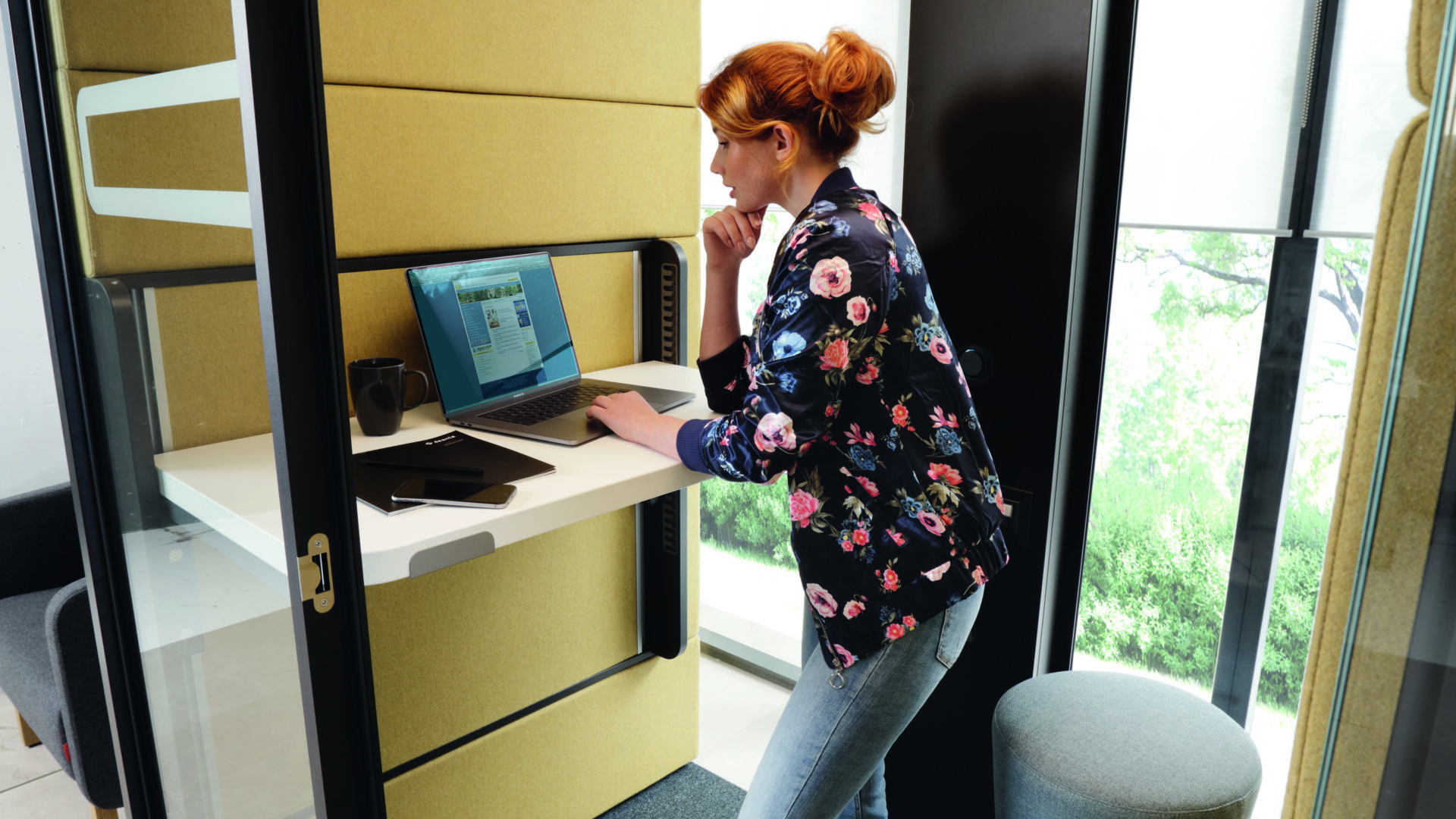
Motion at the workstation may be achieved with the utilisation of basic devices.
Also referred to as fidget furniture. Footrests intended for standing workstation configurations are great because they let workers support one foot at a time while still moving their bodies. As far as sitting workstations are concerned, conventional and rocking footrests might also be great, allowing to keep the body in motion. This sort of movement puts an end to the sitting character of a desk job. Consider desktop transformers, operative seats, standing workstations, and height-configurable workstations.
4. Provide a diverse range of acoustic environments through various treatments and mobile office booths
Such an approach allows staff members to choose the acoustic environment or booth which best suits their requirements. If the thought of workplace sound insulation weighs you down, take a look at our latest blog entry: The quick, comprehensive guide to office noise.

Workplace layout oriented to neuro-inclusivity – pay attention to the following instructions, too:
- Arrange job environments in places with less traffic
- Provide personal work booths and peaceful spaces for periods of deep focus
- Partitions may be employed to minimise or eliminate undesirable commotion
- Urge staff members to put on noise-cancelling headphones if they need it
- To establish a calming acoustic environment, add sound-absorbing elements such as panels, dividing walls, or baffles to every workplace area
- When your environment is overly peaceful, consider getting a white noise generator intended for the open floor
Imagine a workplace where numerous acoustic environments correspond to numerous activities and preferences.
In fact, different soundscapes are suitable for different activities. For instance, greater concentration is often better facilitated by calmer acoustics. As calm as a library. Efficiency is often better facilitated by more vibrant acoustics, such as those found in a crowded coffeehouse.
“Often” is the key term in this case since sound and music are similar. Regardless of our cognitive functioning, we are all unique in our preferences. What helps one worker maintain concentration, undermines it for a different one. Therefore, the tried-and-tested diversity is the best option. It is desirable to provide staff members with a diversity of acoustic areas — each of which occupying a unique spot on the peaceful and vibrant sonic spectrum.
An acoustically varied office means a more efficient office.
The fact that various acoustic settings are suited for various activities is what makes designing a workspace with multiple acoustic areas so beautiful. The ideal level for concentration is 40 dB, whereas the ideal level for inventiveness is 70 dB (therefore, personal office booths, such as hushWork.sit&stand, have a 40-decibel sonic output). To conclude, a wide range of activities is facilitated by an abundant soundscape.
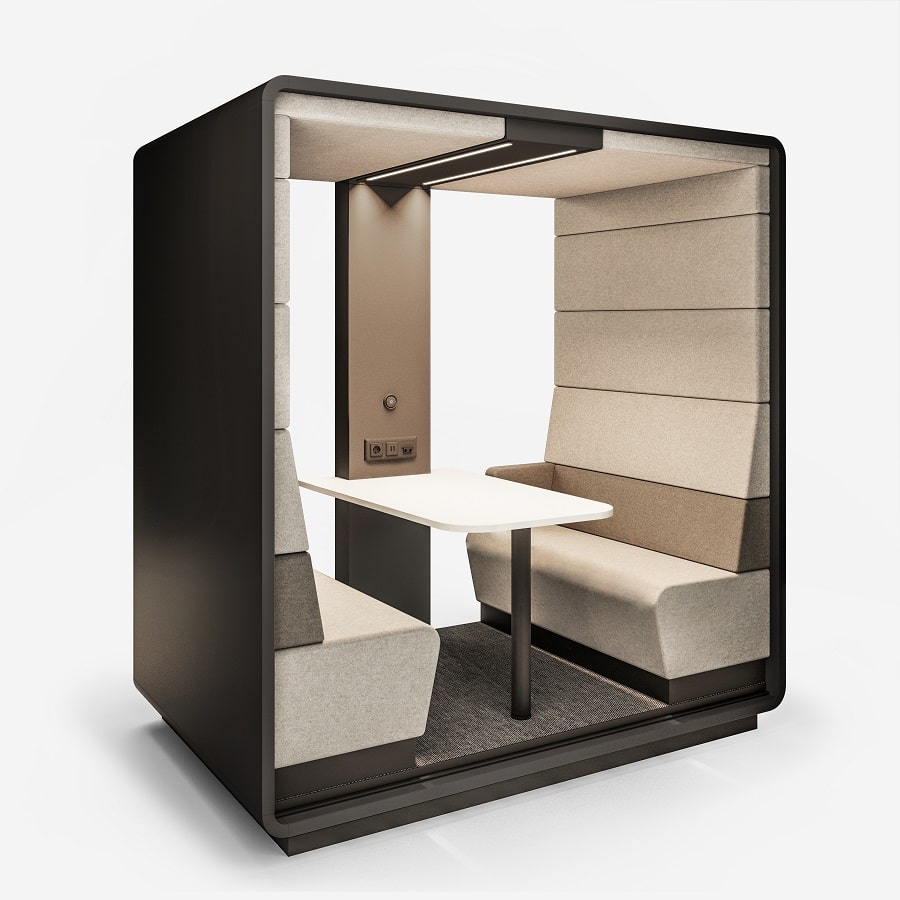
5. Improve illumination, rendering it customisable where feasible.
Aim to distribute different amounts of illumination all over the working environment. It has been demonstrated that intense illumination amplifies both advantageous and disadvantageous feelings. Taking decisions is easier in environments with lower illumination. Thus, it makes sense from a scientific viewpoint to deliver both intense and low illumination all over the workplace.
Lower illumination is favoured by certain individuals because it allows them to feel secure and experience seclusion.
To assess tastes, think about surveying your staff.
The following optimal procedures are also useful:
- Make certain that the illumination in working areas isn’t excessively strong
- Provide configurable illumination where feasible
- Decrease dazzling light by using glare-reducing coatings
- Allow daylight to stream into certain areas of the workplace
- Steer clear of low-quality LED lighting as well as fluorescent illumination
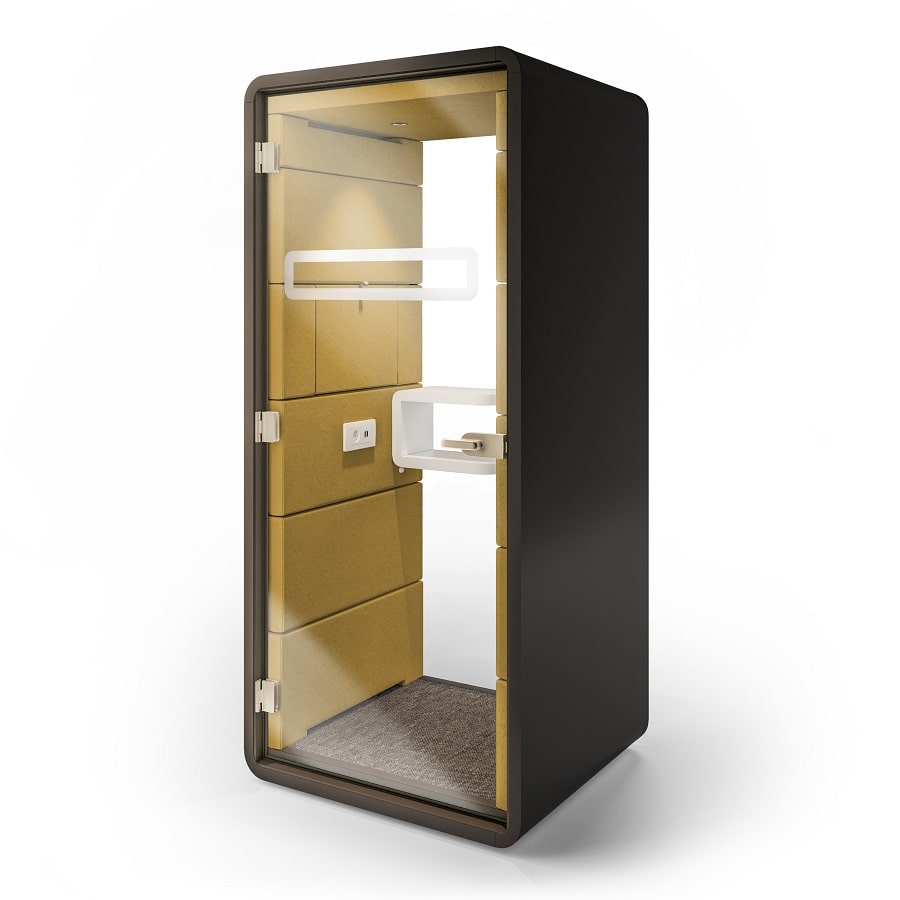
6. Enhance thermal comfort and air purity
A key component of human factors engineering is thermal comfort. Actually, greener workspaces enhance cognitive functioning among workers. What is the precise meaning of ‘greener’? Daylight, clean and adequately ventilated airflow as well as delightful, verdant vegetation. Studies have also demonstrated a simple action like increasing the amount of airflow in the standard workplace (it is less than 40 dollars for each staff member annually) may result in an 8% boost in productivity. It corresponds to a 6,500 dollars annual gain in efficiency.
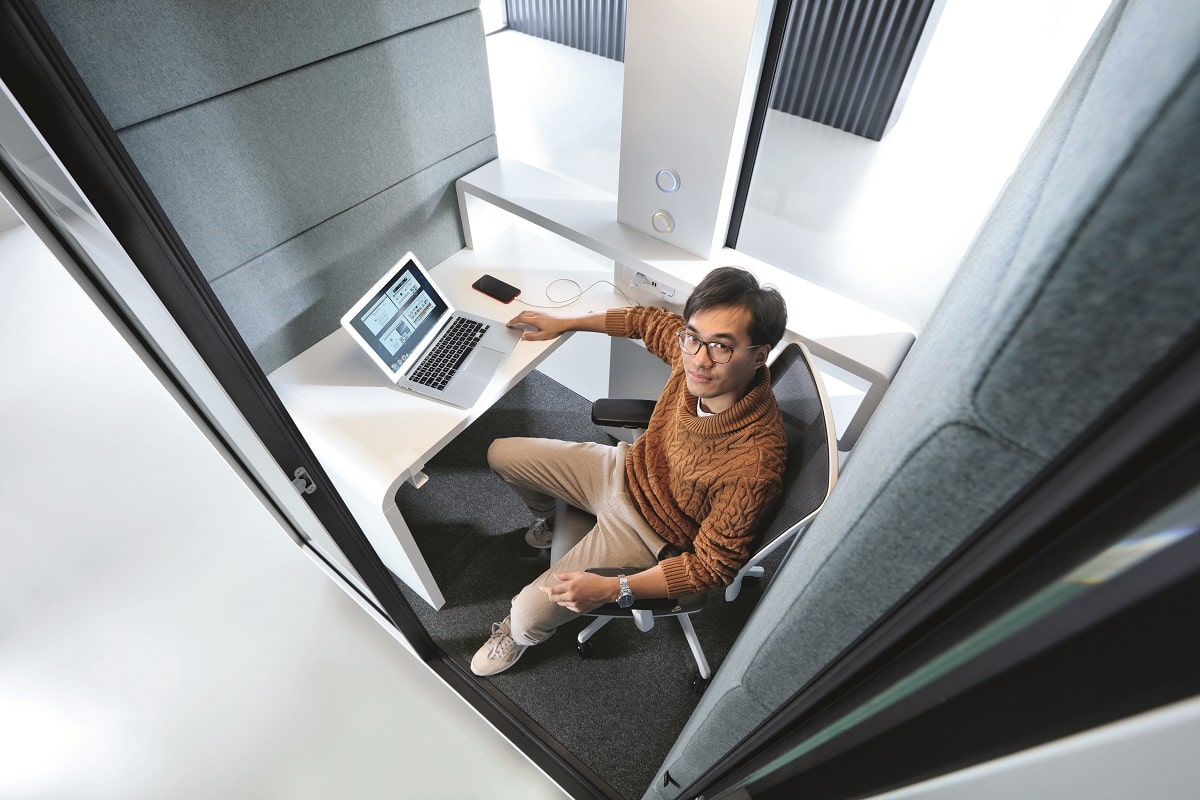
The following may assist you in enhancing thermal comfort and air quality in your workplace:
- Service heating, ventilation and air conditioning systems on a regular basis
- Maintain optimal humidity levels and efficient ventilation across the working area
- Consider purchasing ventilators, and workstation air cleaners
- Introduce more greenery – this will help clean and freshen the air, maintain optimal humidity levels and enhance well-being
- Manage smells from food articles or detergents

7. Cut down on visual interruptions
It’s important to cut down on optical interruptions. Such an approach safeguards concentration. Moreover, it improves visual privacy. This creates a visual atmosphere that blocks out the external environment, helping workers feel comfortable in their work environment. When it comes to staff members who get sidetracked quickly, visual atmosphere is crucial. Additionally, it simultaneously encourages staff members of every stripe to perform more effectively.
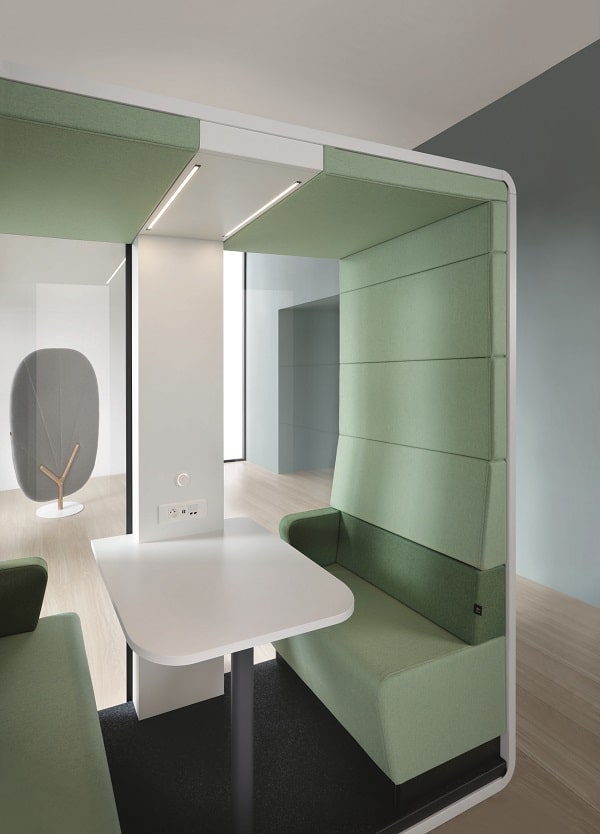
Consider the following reliable suggestions, too:
- All across the working area, alternate between motivational and non-motivational colour schemes
- Steer clear of utilising elaborate designs or hues at office desks
- Change out blinking fluorescent illumination
- Decrease optical chaos, assign an area for storing different items as well as encourage an orderly workstation practice
- Get rid of or shield any glaring gear as well as electronic devices
- Permit staff members to take a seat anywhere they like, even if it’s distant from window panes, doorways or screens
- Invest in private screen protections intended for electronic equipment
- Use organic elements, such as timber, to create an optically soothing impact
- Utilise workstation partitions as well as portable dividers to enhance optical confidentiality
- Urge staff members to set the light intensity of their monitors to a suitable degree
- To ensure greater confidentiality, cover glass walls with special layers, decals, or visuals
- Purchase blue light blocking eyewear
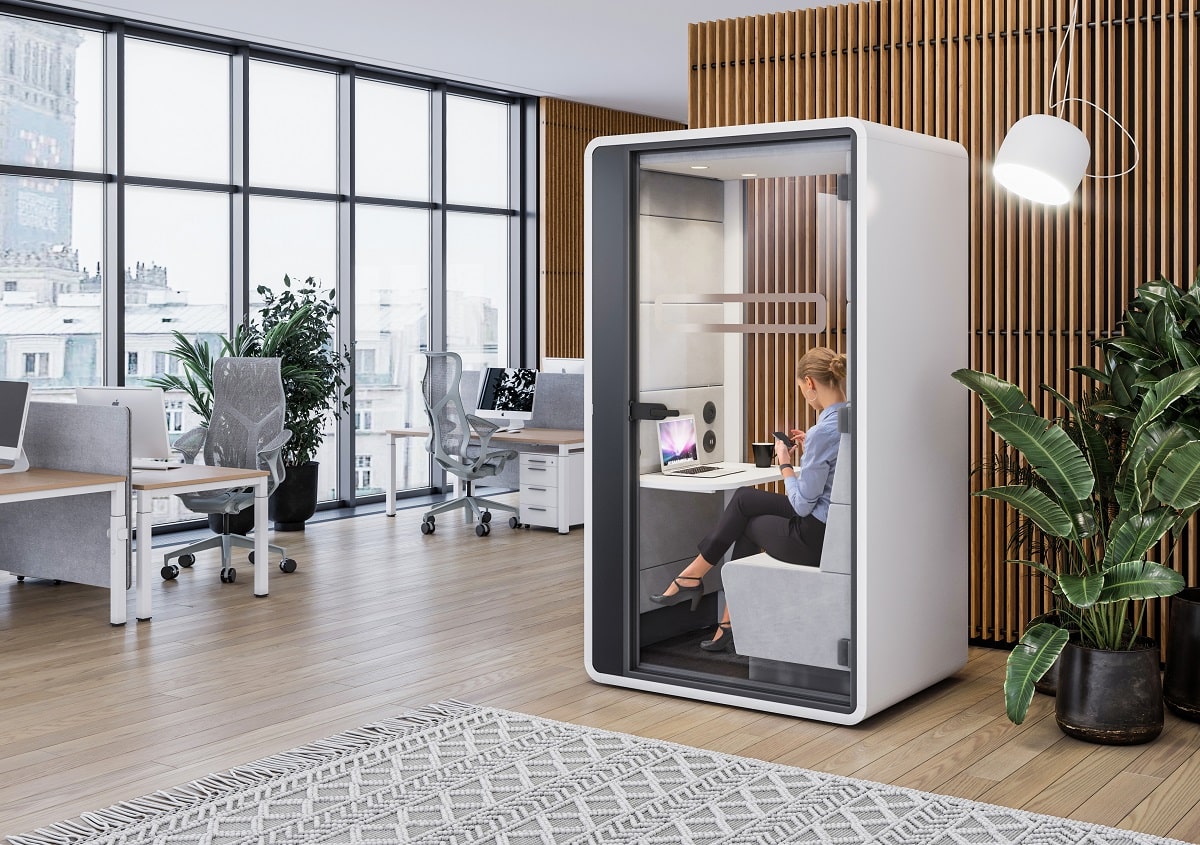
Neurodiversity is a treasure trove of possibilities.
As demonstrated, versatile, inclusivity-oriented layout shares many of the same tenets as ergonomics, biophilia and other wellness-oriented strategies related to workplace layout. Getting rid of intense brightness is beneficial for workers who are sensitive to light. On the other hand, it reduces visual fatigue at various levels, safeguarding your staff members’ vision in the long run. The list of advantages is remarkably extensive.
It ought to encourage a strong determination when it comes to planning as well as readapting for neurodiverse staff members. In the end, we discover that taking neurodiversity into account in the workplace goes beyond simple common sense. It is a treasure trove of possibilities. You simultaneously strengthen the capabilities of both neurotypical and neurodiverse staff members.
The inclusive workplace layout – main conclusions:
- Neurodiversity refers to inherent variations in individuals’ cognitive functioning. Everything depends on our ability to incorporate various senses — the way our brains interpret external stimuli. Unlike neurotypical individuals, who respond to sensory information in a predictable way, neurodiverse individuals can react differently.
- Our five senses are involved in the neural process; therefore, all it takes to cater for neurodiversity is to approach the working environment from a sensory perspective.
- Designing with neurodiversity in mind means planning inclusively – also known as a versatile or inclusive plan.
- Everybody gains from workplace layout that takes neurodiversity into account. Consider soundproof office booths that offer enhanced acoustic environments for both neurotypical and noise-sensitive neurodiverse staff.
- When you adapt the workplace for neurodivergent staff, pay particular attention to these seven fundamentals: visual privacy, acoustic features, illumination, mobility, navigation, airflow, and zoning (partitioning area).
Designing an inclusive office for neurodiverse staff – frequently asked questions
How do we define a neurodiverse individual?
A neurodiverse individual has an unconventional way of thinking compared to average people as their brain interprets information and sensory stimuli differently. Developmental coordination disorder, Tourette’s, attention-deficit hyperactivity disorder, dyscalculia, autism spectrum disorder, obsessive–compulsive disorder, word blindness or dysgraphia are a few instances of neurodiversity.
In what ways can you take neurodiversity into account in the office?
First and foremost, you can take neurodiversity into account by providing your staff with options. Furthermore, you can adjust the sensory circumstances in the office. People’s brains utilise all five senses to interpret the workplace. In addition, neurodiverse individuals frequently have heightened responsiveness to sensory stimuli. That’s why enhancing the sensory circumstances in the workplace — airflow, illumination, acoustics or visual stimulation — benefits the office job for neurotypical and neurodiverse staff members alike. Incentives influence both of them. Provide staff members with the option to customise the aforementioned aspects whenever it is feasible — fresh air, airflow, illumination, and so forth. It enables employees to obtain working areas that are optimal for their distinctive brain programming as well as tastes. Acoustic office booths, such as the Hushoffice collection, constitute a suitable option for neurodiverse staff members since they provide a calm, tranquil, enclosed haven away from the dynamic open space.
In what ways can you accommodate neurodiversity in the workplace?
Devices and furnishings which enhance the sensory circumstances constitute the optimal office options addressing neurodiversity. Acoustic area partitions, workstation dividers, acoustic treatments, personal office booths, such as the hushPhone acoustic call pod and the hushMeet acoustic meeting booths, white noise generators intended for workplace confidentiality, wayfinding and symbols, functional equipment, two-monitor configurations, sound-blocking headphones, anti-glare screen coatings, first-rate surrounding illumination, workstation air cleaners/ventilators/radiators or privacy screen protections intended for electronic equipment rank among the most productive options to consider.
